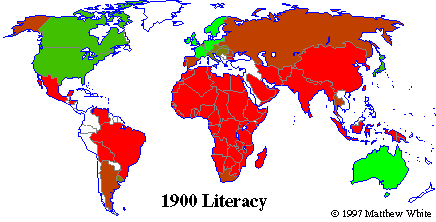



![]()
I'm not going to get into any arguments over whether the glass is half empty or half full, but it's apparent from the maps that a single century is just not long enough for a society to achieve universal literacy from scratch. Of all the countries that have made it into the top rank today, most already had a head start in 1900. Those that started at the bottom are still struggling to catch up, because it takes a major effort for a country to educate its populace. A country needs a large pool of the already educated to act as teachers, and an economy that can detach children from the workforce long enough for them to go to school.
However, by comparing these maps with others, it becomes apparent that the countries which made this commitment early have dominated the century.
By 1900, most of the industrialized countries had instituted free, compulsory education for all children. The rest of the world relied on private tutors and academies for the rich and religious schools for the poor, with mixed results. In Thailand, for example, a large network of Buddhist schools had managed to teach most males to read, but had had almost completely ignored the females.
Of course, education is not the same thing as wisdom, and the most educated countries at the beginning of the Twentieth Century were only 14 years away from blundering into the stupidest war in human history.
Last updated December 1997
Copyright © 1997 Matthew White